The fungus of the nail plate of the feet is called onychomycosis. Firstly, an infectious process hits the thumb, but as development spreads to other. The disease goes through several stages. The earlier treated, the easier it is to solve the problem. This is particularly important with respect to the nail of the thumb and the lower end: it has a great lodge and dimensions, therefore, the magnitude of gross lesions.
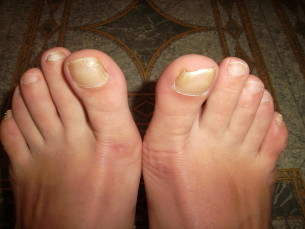
The stage of onychomycosis
The fungus of the nail plate goes through several stages of development, each characterized by specific symptoms. Distinguish the stages of development of the disease:
- Primary. At this stage, visible pathological deviations is not observed: the changes are ominous until the character outside. Nail plate on the fingers of the lower limbs to lose their shine. On the surface of the white spots appear or strips. All in all, the nail seems to be in good health, a person does not feel any pain or discomfort. If identified onychomycosis, at this point, we can fairly quickly get rid of him.
- The average, or progressive. Pathological changes already maintains the structure of the nail. The plate acquires a yellowish tint, flaky and crashes. It also produces a nauseating smell of touch of the foot.
- Launched, or degenerative stage. Occurs a profound defeat of the nails. In this case, the infection passes with the thumb on the rest. The entire surface of the nail plate system by a fungus and is detached from the lodge, becomes loose. The patient concerned itching. If you press on the affected area of the pain and a sensation of pulsation. Because of this, the patient can not wear closed toe shoes.
Degenerative stage of onychomycosis
In the third stage of development of an infection contamination of the skin of the feet. In this case, to cure the fungus can using only the complex therapy, which includes the use of local drugs and medications are systemic (tablets for oral administration).
The reasons for the development of the fungus on the big toe
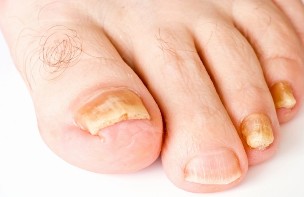
The main causes that lead to the development of onychomycosis include the following:
- communicating with the person who is the bearer of a fungal infection;
- the neglect of hygiene standards;
- the port of a foreign country or narrow, is not appropriate for the size of the shoe;
- the decrease in immunity;
- the visit to the baths, saunas, swimming pools or beauty salons, which may not be used for disinfected tools;
- injuries of the nail and the skin surrounding it;
- flat feet;
- long to receive antibiotics;
- hyperhidrosis (sweating in the area of the stop);
- the presence of national or immune lesions;
- the breach in the circulatory system, which is especially important for elderly patients;
- varicose veins;
- diabetes mellitus.
Flat feet — one of the causes of onychomycosis
An important factor that increases the risk of developing onychomycosis, is the age. Seniors suffer from a poor vascularization of the extremities, which increases the risk of developing fungal infections. The causative agent of the disease occurs on the nail or the skin with infected objects or by contact with the carrier. The pathogen spreads quickly, taking in the new sites. In subungual space, the fungus enters through damaged areas of the plate or of the skin, that surround it. The fungus spreads rapidly, heading toward the art of nails a lodge. The speed of progress is greater than the speed of the growth plate. Soon the pathogen had reached the goal and causes a change in the structure of the nail. Found that the fungus 3 times more likely to suffer men. Nail plate affecting these types of as fungi, dermatophytes, moulds and yeast as.
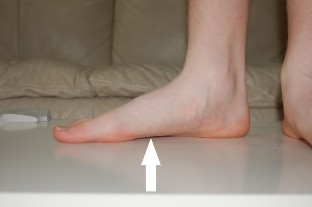
When to see a doctor?
Your doctor should, at the first signs of the fungal defeat. Not worth waiting until there are obvious signs of the disease: the formation of white spots and even itching in the area of the feet should be used as a pretext to resort to an expert – the mycologist or a dermatologist.
The diagnosis
Diagnostic activities that will help identify the disease and its stage, including:
- a visual inspection of the nail plate;
- the collection of a sample of tissue from the victim of the nail;
- cultural research – seeding received by the patient of a material on a fertile ground to identify the types of micro-organisms, affecting the nails.
In some cases, the specialist performs the differential diagnosis and includes a onychomycosis of diseases such as lichen planus, psoriasis, palmo-plantar.
Fungus treatment of the defeat of the nail at a stage of development
If the disease has been identified on the initial stage, in front of him will be much easier. In this case, it is usually sufficient resources at the local level, which makes the water to be treated directly on the affected area of the nail. The duration of treatment depends on the condition of the nail plate and can vary from two to four weeks. The medicines of the tool, which are designed for treatment of even a mild form of nail fungus, should be determined by the physician.
The therapy of the execution of onychomycosis
In the severe forms of the mycosis, and in the case of execution of an infectious process, shows a complete treatment. Necessarily prescribe an antifungal means for systemic action, if no contra-indications. The drugs prescribed to patients:
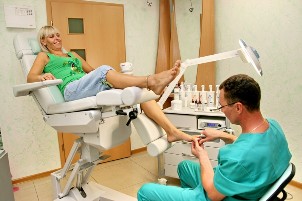
- The system of the antibiotic in the form of tablets. The active substance of the drug reaches the places of localization of pathogens and exerts a fungicidal action.
- The drug inhibits the development of pathogenic agents of disease and destroys them. The course of treatment and dosage are determined by the treating physician. The tool generates side effects.
- The drug has a fungicidal effect. The substance gradually accumulates in the layers of the nail plate, which can destroy even the mushrooms, which are deep enough.
Also when running the fungus nail effective procedures that help get rid the infected of the plate. You can do it in different ways:
- The surgical removal. This method consists of podawanie plate acute surgical device and detach the lodge. After the operation to impose a bandage. The surgical method traumatic and rarely used. Instead of practice of minimally invasive methods.
- The removal of the plate with the aid of chemicals, which accelerate detachment of the nail system. In this case, the problem is treated with a special solution , waiting until the drug begins to act, and then use tools that allow you to separate the nail plate.
- The laser treatment. This is a modern hotel a means painless, which allows you to quickly get rid of the fungal nail. The laser acts on the plate, as quickly as possible by heating it to a high temperature. The beam penetrates deep and neutralizes pathogenic micro-organisms. The method without the shedding of blood, and is safe because it does not cause burns.
During the terminal phase of the onychomycosis is needed in the accuracy of the respect the recommendations of your doctor, because lack of treatment increases the risk of widespread defeat of the organism to the fungal infection.

The traditional methods
The treatment of the fungal infection of the toenail on the big toe can also be performed in combination with the methods of traditional medicine. These means bad omen to a character and may not form the basis of the therapy. The most popular of phenol are the following:
- Gruel onion. Need to grind on a grater a few bulbs and attach the sorbet hit the nails. At the top to attach the band. Leave for 15 to 20 minutes, rinse.
- The peroxide of hydrogen. Hit feet pre-hold in the bowl with water for nails at maximum softened. After this, remove the top layer of plates. Piece of gauze impregnated with hydrogen peroxide and wrap phalange of a finger, hit the nail, by directly entering the foyer of the defeat. Leave 40-50 minutes. Repeat the procedure up to two times per day.
- The apple cider vinegar. It is important to use a natural product. Take 2 tablespoons of vinegar and add the same amount of vodka, and a tablespoon of glycerin. As a result, the composition dip a cotton swab and attach to your nails for 15 minutes. Repeat 4 times per day.
The traditional recipes can help mitigate the severity of the symptoms of the disease and eliminate the discomfort, but they are not able to destroy the pathogens of the disease.
The course of the disease and the characteristics of the therapy of nail fungus in children
In children onychomycosis is quite rare. The main cause of the disease is low-in effect incomplete formation of immunity. Symptoms of onychomycosis among children are:
- the loss of platelets from their natural pinkish color, the emergence of gray or white spots on the surface;
- the roughness and tuberosity, the nail plate;
- the collapse of the and brittle nails;
- redness and swelling of the skin that surrounds the topic ungo of the child.
For the treatment of nail fungus in children generally use only the topical preparations. If necessary, prescribe the means. The safest for the child are capsules . An antifungal medication orally must designate a physician.
Characteristics of treatment in pregnant and lactating women
When the pregnancy is at high risk of developing onychomycosis in this case, if the woman has undergone an illness and is not completely healed her. This is due to the weakening of the immunity, which happens during pregnancy. It is essential to cure the fungus, as in severe cases, it creates the risk of joining a bacterial infection, a threat to the health and of the mother and the fetus. The system of drugs during pregnancy may not be used, because they possess a high level of toxicity. In the period of pregnancy and lactation it is necessary to use local products, but only those that are safe for the future mother and her child. These include sulfuric-ointment salicylic, amicacola ointment.
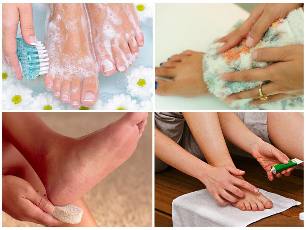
The treatment in the elderly
In the elderly decrease the natural immunity related to the age of one phenomenon, which creates additional risk for the development of onychomycosis. In this case, the specialist is also expressed caution in the choice of the means to treat the fungal infection of the nail plate. The system of prescribed medicines, if the disease lasts for a year and more, as well as in the case of large lesions, and degenerative changes of the nails.
Prevention measures
At the onset of the signs of mould on the little finger or the thumb should immediately consult a physician. But you can take measures to prevent the development of this disease. It is necessary to comply with these recommendations:
- wash the feet at least once a day;
- every day to wash the socks and wear them to the environment;
- in the case of sweating, use of deodorants tools to stop;
- wear shoes appropriate to the size, it should not be too narrow, its needs to be washed every day;
- only use the media for personal hygiene, as well as manicure and pedicure;
- during the visit to the pool, beach, saunas, use your rubber shoes;
- washing the feet with soap after visiting the swimming pool, baths, the need to use a pharmacy, means of preventing.
Fungal infection of the nails of the feet – the disease, which is quite difficult to cure the phase progression. When the first symptoms, you must consult your doctor. The treatment depends on the stage of development of onychomycosis: on the enough drugs of local action in the course of the execution necessary for systemic anti-fungal tool.

















